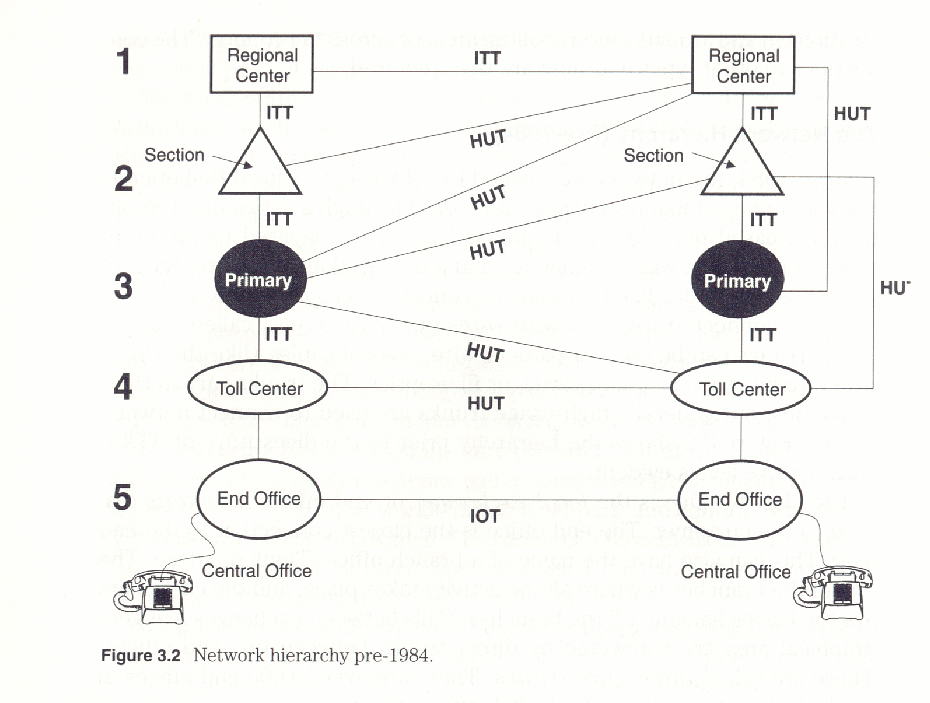The Network Hierarchy (Pre-1984)
Prior to 1984, the network was owned by AT&T and its local Bell operating telephone companies (BOCs). It evolved through a series of interconnections based on volumes of calls and growth. A layered hierarchy of office connections was designed around a five-level architecture. Each of these layers was designed around the concept of call completion. The offices are connected together with wires of various types, called trunks. These trunks can be twisted pairs of wire, coaxial cables (like the CATV wire), radio (such as microwave), or fiberoptics. The trunks vary in their capacities, but generally high-usage trunks are used to connect between offices.
The class-5 office is the local exchange, or end office. It delivers dial tone to the customer. The end office is the closest connection to the end user. This can also have the name of a branch office. Think of a tree. The end of the branches is where all the activity takes place, and the customers are the leaves hanging off the branches. Calls between exchanges in a geographical area are connected by direct trunks between two end offices. These are called inter-office trunks. There are over 19,000 end offices in the U.S. alone that provide basic dial tone services.
The class-4 office is the toll center. A call going between two end offices that are not connected together will be routed to the class 4. The toll center is also used as the connection to the long-distance network, calls where added costs are incurred when a connection is made. This toll center could also be called a tandem office, meaning that calls would have to pass through (or tandem through) this location to get somewhere else on the network. The tandem office usually does not provide dial tone services to the end user. However, this is a variable where a single office might provide various functions. The tandem office can also be just a toll-connecting arrangement that is a pass through from various class-5 offices to the toll centers. Again, this is a variable depending on the arrangements made by the telephone providers. The ratio of toll centers that serve local long distance is approximately 9 to 1. Prior to divestiture, there were approximately 940 toll centers.
The class-3 office is the primary center. Calls destined within the same state area would be passed from the local toll office to the primary center for completion. These locations are served with high-usage trunks that are used strictly for passing calls through it from one toll center to another. The primary centers would never serve dial tones to an end user. The number of primary centers prior to divestiture were approximately 170, spread across the country among the various operating telephone companies (both Bell and independent operating companies).
The class-2 office is the sectional center. A sectional center was typically the main state switching system used for interstate toll connections designated for the processing of long-distance calls from section to section. There were approximately 50+ sectional centers before the divestiture of the Bell System. These offices did not serve any end users, but would serve between primary centers in the country.
The class-1 office is the regional center. Ten regional centers existed across the country. Each center was tasked with the final set-up of calls on a region-by-region basis. However, the regional centers constitute one of the most sophisticated computer systems in the world. The regional centers continually updated each other regarding the status of every circuit in the network. These centers are required to reroute traffic around trouble spots (e.g., failed equipment or circuits) and to keep each other informed at all times. As mentioned, this was all prior to the divestiture of the local Bell operating companies by AT&T. The number of regional centers has changed to seven in the AT&T network, and might be consolidated into four mega centers in the future.
This introduction is meant to teach you about the functions and technology of a Central Office.
Sound
Analog to Digital
Bandwidth
Facilities Network
Traffic Networks
Public Switched
The Telephone Network
A Topology of Connection
Network Hierarchy (pre 1984)
Network Hierarchy (post 1984)
North American Numbering Plan
International Numbering
The Subscriber Extension
Private Networks
Hybrid Networks
Local Access and Transport Areas
Wiring Connections: Hooking Things Up
Types of Communication
Signaling (SS7)
Lines Vs. Trunks
Loop Start
Calling Procedures
Ground Start
E&M Signaling
Foreign Exchange Signal
DID
DOD
FX
OPX
Wats

